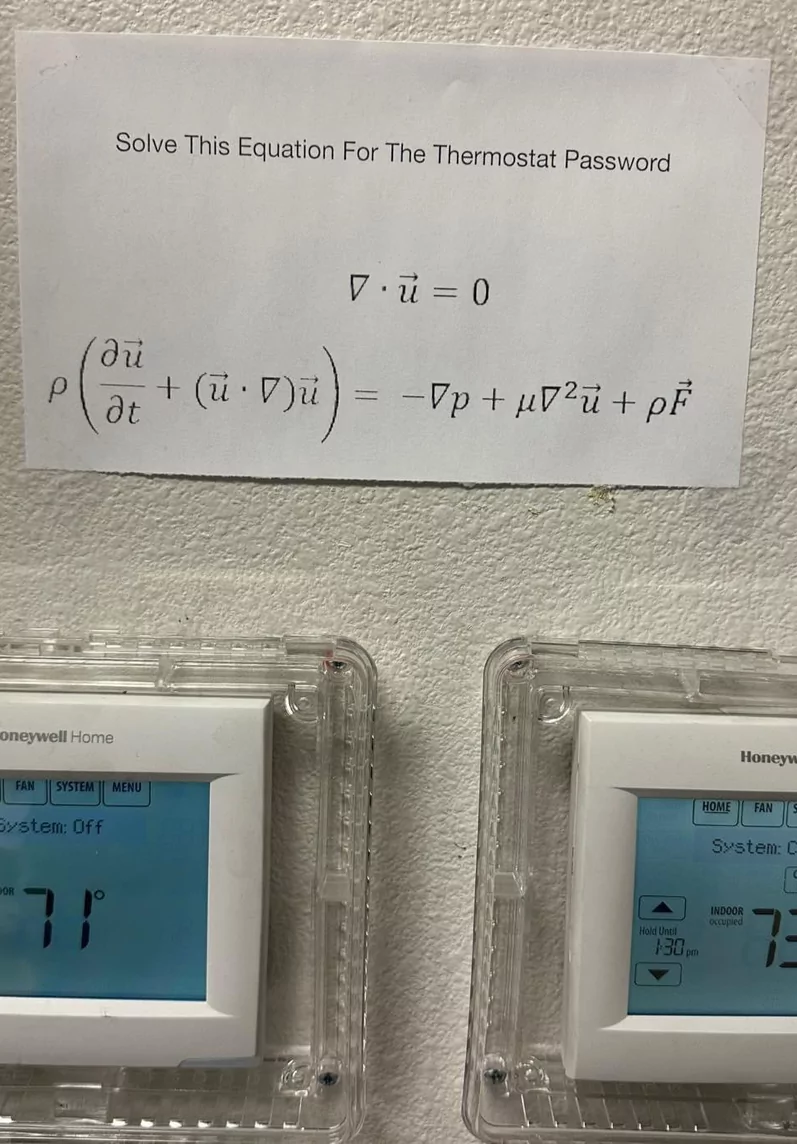This is a fucking differential equation with unknown constants, so yeah, everyone will be burning...
Maybe use c~1~ and c~2~?
The Navier Stokes equations represent the universal laws of physics that can model any fluid in the universe.
These equations have been around since almost two centuries now but we still understand very little about them. When we have a set of equations we expect the following to happen-
-
Solution should exist- One should be able to solve the equations
-
Solution should be unique- Given particular initial conditions, one should obtain an unique solution to the problem. For example if you and your friend pour water into a container in an identical way, keeping all parameters (pouring velocity, direction, geometry and dimensions of the container, etc) identical then you both should get the same flow pattern. Water in both the containers should behave in exactly the same way. If your friend gets air bubbles at a point then you should get them at the exact same point as well.
-
Solution should be smooth- A finite change in the input should produce a finite change in the output. It should not be erratic and unpredictable.
Unfortunately, Navier Stokes equations do not satisfy any of the conditions mentioned above.
https://medium.com/@ases2409/navier-stokes-equations-the-million-dollar-problem-78c01ec05d75
One thing I remember from physics is if you have to guess, the most common answer is zero.
As a physics major this is very true. The answers are always 0, 1, or π
No e?
Only if you are blowing shit up.
If your signal looks like f(t) = K•u(t)e^at with u(t) = {1 if t≥0, 0 else}:
- If Real(a) > 0, then your signal will eventually blow up.
- If Real(a) < 0, then you signal will not blow up. In fact, your signal will have a maximum absolute value of |K|, and it will approach zero as time goes on.
- If Real(a) = 0, it is either a complex sinusoid or a constant. In either case, it is bounded with maximum absolute value of |K|. It very much does not blow up.
So e pops up all the time in stable systems and bounded signals because the function e^at solves the common differential equation dx/dt = ax(t) with x(0)=1 regardless of the value of a, particularly regardless of whether or not the real part of a causes the solution to blow up.
Usually it is e^t or something similar
Used a screen shot to Google this and it turns out to be some unsolved ancient equation regarding the laws of physics. Or something that I dont understand. And have probably misrepresented here.
Wait isn't this just some fluid physics equation?
Like, incompressible fluid flow, iirc.
It looks like it given the symbols used. P for pressure, rho for density etc. u-arrow is definitely a vector field, so it could be fluid flow. Otherwise it could be equally anything described by a vector field, like electromagnetism or gravity but they usually have a lot more E and G involved I think. I used to solve these but then I got a certificate so now I don't have to.
It's a fluid dynamics equation, cannot be analytically solved unless laminar flow assumption is valid.
It really reminds me of all those static and velocity pressure calculations I had to do in undergrad, until I got the degree.
u stands for velocity.
Naviers stokes equation looks incompressibility fluid. Only possible to solve it for strictly laminar flow.
https://en.wikipedia.org/wiki/Navier%E2%80%93Stokes_equations#Incompressible_flow
Irony is, a lot of larger office building thermostats are really only there for display purposes (thermometer), not for control purposes (actually functional).
Often tenants can change the thermostat to whatever they want visually, but in the background it caps at a certain value or doesn't change the set point at all
Am I missing something or does the top equation knock out half the terms? It simplifies to just F = delta + deriv. of u wrt t, right?
(Assuming p =/= 0)
Wait nope some of those ps and us are different. Oh no
Also its not delta, its upside down delta called "Del" (or nabla) which is an operator like derivative but in vector feilds
This deal keeps getting worse every day 😭
Because some of those are rho and mu
Or if you know what you are doing electrically speaking pull the thermostat off the wall and connect the cooling/heating line to common for a bit; I think it would actually be less effort
My work set the password to the facilities manager's phone extension which could just be looked up in the internal directory.
Easy, I just need a wire, toothpaste, bubblegum, and and a watch crystal. Problem solved!
Aren't those locked with actual keys?
No boundary and initial conditions?
Or you could point a flamethrower at the sensor..
For less drastic response, put your hand on the sensor.
Memes
Rules:
- Be civil and nice.
- Try not to excessively repost, as a rule of thumb, wait at least 2 months to do it if you have to.
